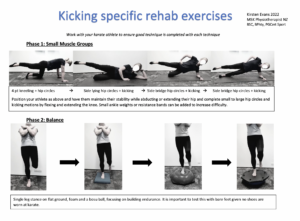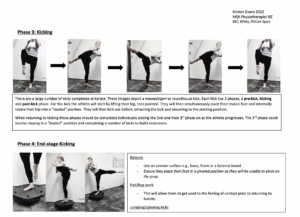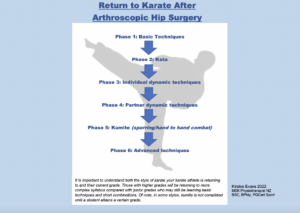Keywords: Karate, arthroscopic surgery, rehab
Managing injuries in high-risk contact or multi-movement sport requires a diverse set of skills and an excellent understanding of the sport by the treating clinician. Literature including Karate athletes is widespread, however, these focus on epidemiology, rather than the rehabilitation of injuries.
The Gap
At the time of my hip surgery no-one was able to comment on my ability to return to Karate or kicking. Literature exploring the physiotherapy rehabilitation of Karate athletes after arthroscopic hip surgery was also scarce. The lack of literature and the collaboration needed during the rehab and return to sport (RTS) phase of my recovery highlighted the gap in RTS knowledge for Karate athletes among clinicians. Given the significance practicing Karate holds to those that engage in it, I have created the following guide to assist clinicians on returning their athletes both to kicking and to Karate after their injury. My hope is that this blog can help to close the gap.
Kicking
Karate encompasses many kicking techniques. The strength and mechanics required to execute these is variable between Karate athletes and type of kick. Given the variability, the below exercises should serve as a base for returning to kicking. Each exercise can be adapted to individual kicks your Karate athlete will be returning to. Normal joint mechanics should be restored prior to commencing this programme and global strengthening of gluteal and other support muscles as per normal rehab guidelines would continue alongside.


“Following hip arthroscopy 82% (95% CI=74–88%) of athletes return to their pre-injury level of sport” (Memon et al., 2018)
Karate encompasses a wide array of techniques from beginner to advanced, static to dynamic, individual to partner work. Given the variety available to Karate athletes, a RTS can be facilitated following restoration of baseline strength and joint mechanics.

Phase 1: Basic Techniques
Basic techniques: punches, strikes, blocks, kicks and stances as tolerated by the athlete. These can be progressed to completing techniques while moving through stances.
Emphasis is on technique rather than speed or power
Phase 2: Kata
Kata is made up of a series of techniques and stances completed in multiple directions at varying speeds and intensities. These can be slowly returned to as tolerated at reduced intensity.
Phase 3: Individual dynamic techniques
The ability to complete combinations of techniques is important in Karate practice. Initially this can be completed at a slow speed, increasing speed as tolerated.
Phase 4: Partner dynamic techniques
This is inclusive of all partner work excluding sparring. Typically, this is choreographed sequences of techniques with both an attacker and a defender. The Karate athlete should slowly reintroduce any takedowns as tolerated.
Phase 5: Kumite (sparring/hand to hand combat)
Kumite has varying rules depending on the style of Karate. Rules may vary from full body contact to points sparring where an opponent will move in to score a “point” and then move back. When your athlete can comfortably complete all other training, they can progress to kumite.
Phase 6: Advanced techniques
As tolerated – may be inclusive of weapon work
Conclusion:
Returning to Karate after any injury is challenging. There is no perfect time frametimeframe, however, there is a great variability in intensity and physical requirements of different aspects of Karate. Given the immense importance Karate has to its practitioners, the earlier your Karate athlete enters the dojo the better. The lack of literature and the collaboration needed during the rehab and RTS phase of my recovery highlighted the gap in RTS knowledge for Karate athletes among clinicians. Let this blog start to close that gap.
Authors name and affiliations
Kirsten Evans is a musculoskeletal physiotherapist undertaking her Sports Physiotherapy post graduate studies at the School of Physiotherapy, University of Otago, New Zealand. She is a practicing Senior physiotherapist for Habit Health Christchurch and trains at Seido Karate Christchurch.
References
Gavagan, C. J., & Sayers, M. G. L. (2017). A biomechanical analysis of the roundhouse kicking technique of expert practitioners: A comparison between the martial arts disciplines of Muay Thai, Karate, and Taekwondo. PLoS One, 12(8), Article e0182645. https://doi.org/10.1371/journal.pone.0182645
Memon, M., Kay, J., Hache, P., Simunovic, N., Harris, J. D., O’Donnell, J., & Ayeni, O. R. (2018). Athletes experience a high rate of return to sport following hip arthroscopy. Knee Surgery, Sports Traumatology, Arthroscopy, 27(10), 3066-3104. https://doi.org/10.1007/s00167-018-4929-z